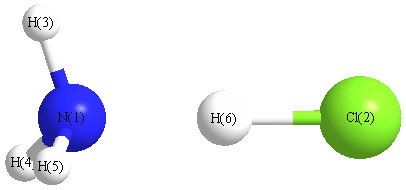Vibrational Frequencies calculated at BLYP/6-311+G(3df,2p)
| Mode Number |
Symmetry |
Frequency
(cm-1) |
Scaled Frequency
(cm-1) |
IR Intensities
(km mol-1) |
Raman Act
(Å4/u) |
Dep P |
Dep U |
|---|
| 1 |
A1 |
3378 |
3359 |
0.01 |
|
|
|
| 2 |
A1 |
2043 |
2031 |
2240.70 |
|
|
|
| 3 |
A1 |
1080 |
1075 |
86.40 |
|
|
|
| 4 |
A1 |
191 |
189 |
38.42 |
|
|
|
| 5 |
E |
3493 |
3474 |
14.82 |
|
|
|
| 5 |
E |
3493 |
3474 |
14.82 |
|
|
|
| 6 |
E |
1624 |
1615 |
22.37 |
|
|
|
| 6 |
E |
1624 |
1615 |
22.37 |
|
|
|
| 7 |
E |
823 |
819 |
25.15 |
|
|
|
| 7 |
E |
823 |
819 |
25.15 |
|
|
|
| 8 |
E |
249 |
248 |
13.65 |
|
|
|
| 8 |
E |
249 |
248 |
13.65 |
|
|
|
Unscaled Zero Point Vibrational Energy (zpe) 9534.5 cm
-1
Scaled (by 0.9945) Zero Point Vibrational Energy (zpe) 9482.0 cm
-1
See section
III.C.1 List or set vibrational scaling factors
to change the scale factors used here.
See section
III.C.2
Calculate a vibrational scaling factor for a given set of molecules
to determine the least squares best scaling factor.
Charges, Dipole, Quadrupole and Polarizability
Charges from optimized geometry at BLYP/6-311+G(3df,2p)
Charges (e)
| Number |
Element |
Mulliken |
CHELPG |
AIM |
ESP |
| 1 |
N |
-0.589 |
|
|
|
| 2 |
Cl |
-0.438 |
|
|
|
| 3 |
H |
0.214 |
|
|
|
| 4 |
H |
0.214 |
|
|
|
| 5 |
H |
0.214 |
|
|
|
| 6 |
H |
0.386 |
|
|
|
Electric dipole moments
Electric dipole components in Debye
(What's a Debye? See section
VII.A.3)
| |
x |
y |
z |
Total |
| |
0.000 |
0.000 |
-4.759 |
4.759 |
| CHELPG |
|
|
|
|
| AIM |
|
|
|
|
| ESP |
|
|
|
|
Electric Quadrupole moment
Quadrupole components in D Å
| Primitive |
|---|
| | x | y | z |
|---|
| x |
-20.730 |
0.000 |
0.000 |
| y |
0.000 |
-20.730 |
0.000 |
| z |
0.000 |
0.000 |
-15.880 |
|
| Traceless |
|---|
| | x | y | z |
|---|
| x |
-2.425 |
0.000 |
0.000 |
| y |
0.000 |
-2.425 |
0.000 |
| z |
0.000 |
0.000 |
4.850 |
|
| Polar |
|---|
| 3z2-r2 | 9.701 |
|---|
| x2-y2 | 0.000 |
|---|
| xy | 0.000 |
|---|
| xz | 0.000 |
|---|
| yz | 0.000 |
|---|
|
Polarizabilities
Components of the polarizability tensor.
Units are
Å
3 (Angstrom cubed)
Change units.
| |
x |
y |
z |
| x |
4.220 |
0.000 |
0.000 |
| y |
0.000 |
4.220 |
0.000 |
| z |
0.000 |
0.000 |
7.041 |
<r2> (average value of r
2) Å
2
| <r2> |
79.352 |
| (<r2>)1/2 |
8.908 |
